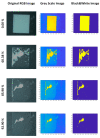Preparation, Properties and Water Dissolution Behavior of Polyethylene Oxide Mats Prepared by Solution Blow Spinning
- PMID: 35406174
- PMCID: PMC9003185
- DOI: 10.3390/polym14071299
Preparation, Properties and Water Dissolution Behavior of Polyethylene Oxide Mats Prepared by Solution Blow Spinning
Abstract
The relationship between processing conditions, structure and morphology are key issues to understanding the final properties of materials. For instance, in the case of polymers to be used as scaffolds in tissue engineering, wound dressings and membranes, morphology tuning is essential to control mechanical and wettability behaviors. In this work, the relationship between the processing conditions of the solution blow spinning process (SBS) used to prepare nonwoven mats of polyethylene oxide (PEO), and the structure and morphology of the resulting materials are studied systematically, to account for the thermal and mechanical behaviors and dissolution in water. After finding the optimal SBS processing conditions (air pressure, feed rate, working distance and polymer concentration), the effect of the solvent composition has been considered. The structure and morphology of the blow spun fibers are studied as well as their thermal, mechanical behaviors and dissolution in water. We demonstrate that the morphology of the fibers (size and porosity) changes with the solvent composition, which is reflected in different thermal and mechanical responses and in the dissolution rates of the materials in water.
Keywords: materials characterization; morphology; polyethylene oxide; polymer dissolution; solution blow spinning.
Conflict of interest statement
The authors declare no conflict of interest.
Figures











References
-
- Niazmand R., Razavizadeh B.M. Active Polyethylene Films Incorporated with β-Cyclodextrin/Ferula Asafoetida Extract Inclusion Complexes: Sustained Release of Bioactive Agents. Polym. Test. 2021;95:107113. doi: 10.1016/j.polymertesting.2021.107113. - DOI
-
- Zaitoon A., Lim L.T., Scott-Dupree C. Activated Release of Ethyl Formate Vapor from Its Precursor Encapsulated in Ethyl Cellulose/Poly(Ethylene Oxide) Electrospun Nonwovens Intended for Active Packaging of Fresh Produce. Food Hydrocoll. 2021;112:106313. doi: 10.1016/j.foodhyd.2020.106313. - DOI
Grants and funding
LinkOut - more resources
Full Text Sources

